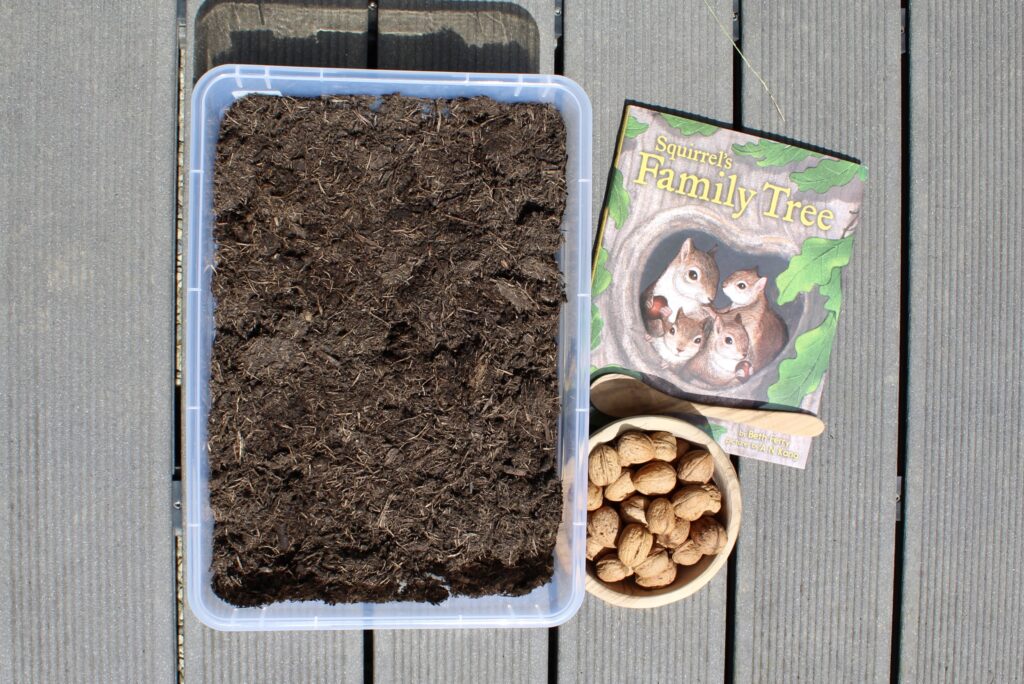Bury The Nuts (Autumn Sensory Bin)
Create a simple autumn sensory bin using nuts and garden soil. This fun and seasonal activity is perfect for teaching toddlers about squirrels in a hands-on way!

We live in an area full of squirrels allowing my toddler and I to observe their behaviour year-round from our balcony. In spring and summer, we watch them dance around the treetops. In autumn we see them diligently collecting and burying their nuts.
With autumn upon us once more, we have spent many mornings on the balcony watching the squirrels as they prepare for winter. While telling my toddler all about squirrels and their nuts recently, it struck me that burying nuts would make for a great sensory play activity.
Bury the Nuts – A Simple Fall Sensory Activity
This sensory bin activity is the perfect activity for fall, allowing your toddler or preschooler to engage their senses while learning about the seasonal behavior of squirrels.
Setting up the sensory bin couldn’t be easier. Simply gather your supplies and introduce the activity by telling your child that they are squirrels preparing for winter by burying their nuts in the dirt. For added fun, you could use a little toy squirrel, explaining that it’s looking for a friend to help bury its nuts before winter arrives.

If you’ve recently seen squirrels burying nuts on a nature walk, that might be enough of an introduction. However, if your little one isn’t familiar with squirrels burying nuts for winter, a book can help set the stage for this sensory play activity. Check out my book recommendation for this sensory bin down below.
Once you’ve introduced the sensory bin, tell your child to place a nut into the dirt and cover it with more dirt using a spoon. For younger toddlers, demonstrate how to do it first before inviting them to give it a go.
Then, let them explore and enjoy the activity. My daughter loved getting her hands all up in the dirt and I’ve yet to hear about a toddler who doesn’t. (Yes, things will get a bit messy! I recommend doing this sensory bin outdoors or placing a big plastic sheet under the container).
My 24-month-old spent about 25 minutes exploring this sensory bin. I encouraged her efforts a handful of times, but largely let her explore to her heart’s content after the initial introduction.

Other easy fall sensory bin ideas:
- Fall harvest corn sensory bin
- Fall leaves sensory bin
- Apple juice oobleck
- Color sorting fall sensory bin
- Pumpkin sensory bin
Supplies and Set Up

You likely have most of the supplies needed for this sensory bin activity at home. Optional items like the recommended book and toy squirrel can easily be purchased online.
For this fall activity you’ll need the following:
- A large container – you could also use a plastic sheet to contain the dirt
- A bag of garden soil
- Some nuts or acorns – we used walnuts from my mother’s walnut tree
- A spoon
- A toy squirrel (optional)
- Squirrel’s Family Tree by Beth Ferry (optional)
Autumn Sensory Bin: Age and Skills Developed

Age recommendation: This sensory play idea is generally suitable for children aged 18 months to 4 years. However, instead of judging this activity by age, think about whether it would be suitable for your specific child. Would they enjoy playing with mud? Are they able to hold a spoon? Can they sustain their focus for at least 10 minutes?
Skills developed: This sensory activity not only introduces young children to squirrel behavior and new vocabulary but also benefits their development. Some of the skills that your child will work on during this activity include:
– Hand-eye coordination
– Grip strength
– Bilateral coordination
– Crossing the midline
– Fine motor development
– Spatial awareness
– Capacity (how much soil can each hole hold?)
– Problem solving
– Imaginary and creative play
Book Recommendation

I already mentioned Squirrel’s Family Tree by Beth Ferry in the supplies section, but it is so good it deserves a special mention.
This book tells the story of squirrels and their intricate relationship with oak trees. Not only will your little one learn about squirrels hiding their nuts (acorns in this case) in autumn, but also about the crucial role this behavior plays in growing new oak trees.
With beautiful illustrations by A. N. Kang and charming rhymes, this book is not only the perfect addition to this sensory activity but also a new favorite in our book collection.


